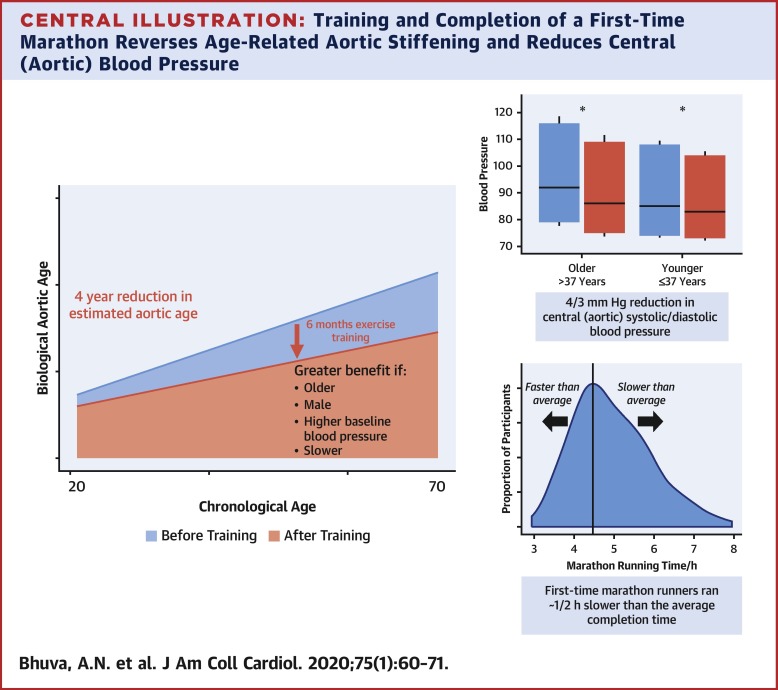当前位置:
X-MOL 学术
›
J. Am. Coll. Cardiol.
›
论文详情
Our official English website, www.x-mol.net, welcomes your feedback! (Note: you will need to create a separate account there.)
Training for a First-Time Marathon Reverses Age-Related Aortic Stiffening
Journal of the American College of Cardiology ( IF 24.0 ) Pub Date : 2020-01-01 , DOI: 10.1016/j.jacc.2019.10.045 Anish N Bhuva 1 , Andrew D'Silva 2 , Camilla Torlasco 3 , Siana Jones 4 , Niromila Nadarajan 4 , Jet Van Zalen 5 , Nish Chaturvedi 4 , Guy Lloyd 5 , Sanjay Sharma 2 , James C Moon 1 , Alun D Hughes 4 , Charlotte H Manisty 1
Journal of the American College of Cardiology ( IF 24.0 ) Pub Date : 2020-01-01 , DOI: 10.1016/j.jacc.2019.10.045 Anish N Bhuva 1 , Andrew D'Silva 2 , Camilla Torlasco 3 , Siana Jones 4 , Niromila Nadarajan 4 , Jet Van Zalen 5 , Nish Chaturvedi 4 , Guy Lloyd 5 , Sanjay Sharma 2 , James C Moon 1 , Alun D Hughes 4 , Charlotte H Manisty 1
Affiliation

|
BACKGROUND
Aging increases aortic stiffness, contributing to cardiovascular risk even in healthy individuals. Aortic stiffness is reduced through supervised training programs, but these are not easily generalizable. OBJECTIVES
The purpose of this study was to determine whether real-world exercise training for a first-time marathon can reverse age-related aortic stiffening. METHODS
Untrained healthy individuals underwent 6 months of training for the London Marathon. Assessment pre-training and 2 weeks post-marathon included central (aortic) blood pressure and aortic stiffness using cardiovascular magnetic resonance distensibility. Biological "aortic age" was calculated from the baseline chronological age-stiffness relationship. Change in stiffness was assessed at the ascending (Ao-A) and descending aorta at the pulmonary artery bifurcation (Ao-P) and diaphragm (Ao-D). Data are mean changes (95% confidence intervals [CIs]). RESULTS
A total of 138 first-time marathon completers (age 21 to 69 years, 49% male) were assessed, with an estimated training schedule of 6 to 13 miles/week. At baseline, a decade of chronological aging correlated with a decrease in Ao-A, Ao-P, and Ao-D distensibility by 2.3, 1.9, and 3.1 × 10-3 mm Hg-1, respectively (p < 0.05 for all). Training decreased systolic and diastolic central (aortic) blood pressure by 4 mm Hg (95% CI: 2.8 to 5.5 mm Hg) and 3 mm Hg (95% CI: 1.6 to 3.5 mm Hg). Descending aortic distensibility increased (Ao-P: 9%; p = 0.009; Ao-D: 16%; p = 0.002), while remaining unchanged in the Ao-A. These translated to a reduction in "aortic age" by 3.9 years (95% CI: 1.1 to 7.6 years) and 4.0 years (95% CI: 1.7 to 8.0 years) (Ao-P and Ao-D, respectively). Benefit was greater in older, male participants with slower running times (p < 0.05 for all). CONCLUSIONS
Training for and completing a marathon even at relatively low exercise intensity reduces central blood pressure and aortic stiffness-equivalent to a ∼4-year reduction in vascular age. Greater rejuvenation was observed in older, slower individuals.
中文翻译:

首次马拉松训练可逆转与年龄相关的主动脉硬化
背景衰老会增加主动脉僵硬,甚至在健康个体中也会增加心血管风险。通过有监督的训练计划可以降低主动脉僵硬度,但这些计划不容易推广。目的 本研究的目的是确定首次参加马拉松的真实世界运动训练是否可以逆转与年龄相关的主动脉硬化。方法 未经训练的健康人为伦敦马拉松接受了 6 个月的训练。训练前和马拉松后 2 周的评估包括使用心血管磁共振扩张性的中心(主动脉)血压和主动脉僵硬度。生物“主动脉年龄”是根据基线年龄-刚度关系计算的。在肺动脉分叉处 (Ao-P) 和横膈膜 (Ao-D) 处评估升主动脉 (Ao-A) 和降主动脉的刚度变化。数据是平均变化(95% 置信区间 [CI])。结果 共有 138 名首次马拉松完成者(年龄 21 至 69 岁,男性占 49%)接受评估,估计训练计划为 6 至 13 英里/周。在基线时,10 年的按时间顺序老化与 Ao-A、Ao-P 和 Ao-D 的可扩张性分别降低 2.3、1.9 和 3.1 × 10-3 mm Hg-1(所有 p < 0.05) . 训练使收缩压和舒张中心(主动脉)血压降低了 4 毫米汞柱(95% CI:2.8 至 5.5 毫米汞柱)和 3 毫米汞柱(95% CI:1.6 至 3.5 毫米汞柱)。降主动脉扩张性增加(Ao-P:9%;p = 0.009;Ao-D:16%;p = 0.002),而在 Ao-A 中保持不变。这些转化为“主动脉年龄”减少 3.9 年(95% CI:1.1 至 7.6 年)和 4.0 年(95% CI:1.7 至 8.0 年)(分别为 Ao-P 和 Ao-D)。跑步时间较慢的老年男性参与者的获益更大(所有 p < 0.05)。结论 即使在相对较低的运动强度下训练和完成马拉松也能降低中心血压和主动脉僵硬——相当于血管年龄减少约 4 年。在较老、较慢的个体中观察到更大的恢复活力。结论 即使在相对较低的运动强度下训练和完成马拉松也能降低中心血压和主动脉僵硬——相当于血管年龄减少约 4 年。在较老、较慢的个体中观察到更大的恢复活力。结论 即使在相对较低的运动强度下训练和完成马拉松也能降低中心血压和主动脉僵硬——相当于血管年龄减少约 4 年。在较老、较慢的个体中观察到更大的恢复活力。
更新日期:2020-01-01
中文翻译:

首次马拉松训练可逆转与年龄相关的主动脉硬化
背景衰老会增加主动脉僵硬,甚至在健康个体中也会增加心血管风险。通过有监督的训练计划可以降低主动脉僵硬度,但这些计划不容易推广。目的 本研究的目的是确定首次参加马拉松的真实世界运动训练是否可以逆转与年龄相关的主动脉硬化。方法 未经训练的健康人为伦敦马拉松接受了 6 个月的训练。训练前和马拉松后 2 周的评估包括使用心血管磁共振扩张性的中心(主动脉)血压和主动脉僵硬度。生物“主动脉年龄”是根据基线年龄-刚度关系计算的。在肺动脉分叉处 (Ao-P) 和横膈膜 (Ao-D) 处评估升主动脉 (Ao-A) 和降主动脉的刚度变化。数据是平均变化(95% 置信区间 [CI])。结果 共有 138 名首次马拉松完成者(年龄 21 至 69 岁,男性占 49%)接受评估,估计训练计划为 6 至 13 英里/周。在基线时,10 年的按时间顺序老化与 Ao-A、Ao-P 和 Ao-D 的可扩张性分别降低 2.3、1.9 和 3.1 × 10-3 mm Hg-1(所有 p < 0.05) . 训练使收缩压和舒张中心(主动脉)血压降低了 4 毫米汞柱(95% CI:2.8 至 5.5 毫米汞柱)和 3 毫米汞柱(95% CI:1.6 至 3.5 毫米汞柱)。降主动脉扩张性增加(Ao-P:9%;p = 0.009;Ao-D:16%;p = 0.002),而在 Ao-A 中保持不变。这些转化为“主动脉年龄”减少 3.9 年(95% CI:1.1 至 7.6 年)和 4.0 年(95% CI:1.7 至 8.0 年)(分别为 Ao-P 和 Ao-D)。跑步时间较慢的老年男性参与者的获益更大(所有 p < 0.05)。结论 即使在相对较低的运动强度下训练和完成马拉松也能降低中心血压和主动脉僵硬——相当于血管年龄减少约 4 年。在较老、较慢的个体中观察到更大的恢复活力。结论 即使在相对较低的运动强度下训练和完成马拉松也能降低中心血压和主动脉僵硬——相当于血管年龄减少约 4 年。在较老、较慢的个体中观察到更大的恢复活力。结论 即使在相对较低的运动强度下训练和完成马拉松也能降低中心血压和主动脉僵硬——相当于血管年龄减少约 4 年。在较老、较慢的个体中观察到更大的恢复活力。


























 京公网安备 11010802027423号
京公网安备 11010802027423号